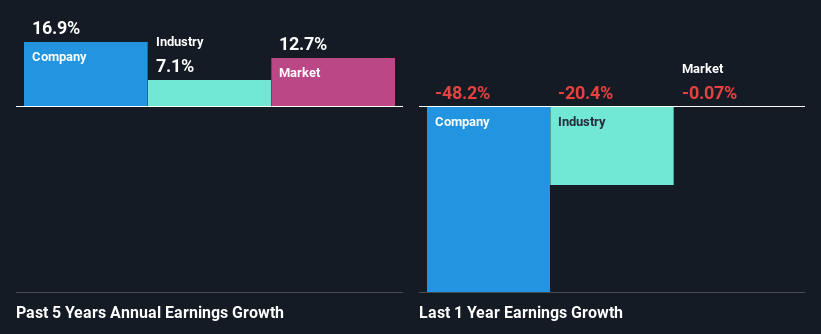- United States
- /
- Packaging
- /
- NasdaqGS:TRS
TriMas Corporation's (NASDAQ:TRS) Stock Has Shown Weakness Lately But Financial Prospects Look Decent: Is The Market Wrong?

With its stock down 9.1% over the past week, it is easy to disregard TriMas (NASDAQ:TRS). However, stock prices are usually driven by a company’s financials over the long term, which in this case look pretty respectable. In this article, we decided to focus on TriMas' ROE.
Return on equity or ROE is an important factor to be considered by a shareholder because it tells them how effectively their capital is being reinvested. Simply put, it is used to assess the profitability of a company in relation to its equity capital.
Check out our latest analysis for TriMas
How Is ROE Calculated?
Return on equity can be calculated by using the formula:
Return on Equity = Net Profit (from continuing operations) ÷ Shareholders' Equity
So, based on the above formula, the ROE for TriMas is:
3.9% = US$27m ÷ US$683m (Based on the trailing twelve months to September 2024).
The 'return' refers to a company's earnings over the last year. So, this means that for every $1 of its shareholder's investments, the company generates a profit of $0.04.
What Is The Relationship Between ROE And Earnings Growth?
So far, we've learned that ROE is a measure of a company's profitability. Depending on how much of these profits the company reinvests or "retains", and how effectively it does so, we are then able to assess a company’s earnings growth potential. Assuming everything else remains unchanged, the higher the ROE and profit retention, the higher the growth rate of a company compared to companies that don't necessarily bear these characteristics.
TriMas' Earnings Growth And 3.9% ROE
It is quite clear that TriMas' ROE is rather low. Even when compared to the industry average of 13%, the ROE figure is pretty disappointing. However, the moderate 17% net income growth seen by TriMas over the past five years is definitely a positive. Therefore, the growth in earnings could probably have been caused by other variables. Such as - high earnings retention or an efficient management in place.
We then compared TriMas' net income growth with the industry and we're pleased to see that the company's growth figure is higher when compared with the industry which has a growth rate of 7.1% in the same 5-year period.

The basis for attaching value to a company is, to a great extent, tied to its earnings growth. What investors need to determine next is if the expected earnings growth, or the lack of it, is already built into the share price. Doing so will help them establish if the stock's future looks promising or ominous. Is TriMas fairly valued compared to other companies? These 3 valuation measures might help you decide.
Is TriMas Using Its Retained Earnings Effectively?
In TriMas' case, its respectable earnings growth can probably be explained by its low three-year median payout ratio of 12% (or a retention ratio of 88%), which suggests that the company is investing most of its profits to grow its business.
Moreover, TriMas is determined to keep sharing its profits with shareholders which we infer from its long history of three years of paying a dividend.
Summary
In total, it does look like TriMas has some positive aspects to its business. Even in spite of the low rate of return, the company has posted impressive earnings growth as a result of reinvesting heavily into its business. While we won't completely dismiss the company, what we would do, is try to ascertain how risky the business is to make a more informed decision around the company. To know the 3 risks we have identified for TriMas visit our risks dashboard for free.
Valuation is complex, but we're here to simplify it.
Discover if TriMas might be undervalued or overvalued with our detailed analysis, featuring fair value estimates, potential risks, dividends, insider trades, and its financial condition.
Access Free AnalysisHave feedback on this article? Concerned about the content? Get in touch with us directly. Alternatively, email editorial-team (at) simplywallst.com.
This article by Simply Wall St is general in nature. We provide commentary based on historical data and analyst forecasts only using an unbiased methodology and our articles are not intended to be financial advice. It does not constitute a recommendation to buy or sell any stock, and does not take account of your objectives, or your financial situation. We aim to bring you long-term focused analysis driven by fundamental data. Note that our analysis may not factor in the latest price-sensitive company announcements or qualitative material. Simply Wall St has no position in any stocks mentioned.
About NasdaqGS:TRS
TriMas
Engages in the design, development, manufacture, and sale of products for consumer products, aerospace, and industrial markets worldwide.
Moderate growth potential with questionable track record.


